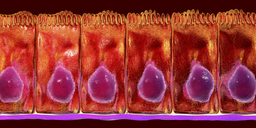Intercellular Junction Proteins and Food Allergy
TECHNOLOGY NUMBER: 2020-239

OVERVIEW
A diagnostic test that determines ongoing or recent anaphylaxis- Detection of gut mucosa enzymes which are cleaved during anaphylaxis
- May provide a means to anticipate and ameliorate anaphylactic episodes
BACKGROUND
Allergies to certain foods cause reactions mediated by the immune system. In the most severe cases, an allergic reaction to food can lead to a life-threatening reaction called anaphylaxis. The inflammatory cascade leading to anaphylaxis is mediated by stimulation of IgE antibodies and activation of mast cells in the gastrointestinal system. Epithelial cells lining the intestine are normally connected by intracellular junctions which form a tight barrier between the contents of the intestine and the lumen of the gut. These junctions allow for the transfer of nutrients across cell membranes while keeping toxins and bacteria outside of the cells.
Any dysfunction or breakdown of these intracellular junctions can create a scenario where food borne substances cause a series of immune-related events which manifest as the allergy. Anaphylaxis is currently diagnosed by the presence of symptoms in a short time frame following exposure to a potential allergen, especially in patients with a previous history of allergic reactions or positive intradermal skin prick testing. A blood test that determines the level of tryptase enzyme may also prove useful, though that measurement is not easily obtained in real time. A need therefore exists for a diagnostic test that confirms anaphylaxis as it occurs.
INNOVATION
Researchers have discovered that food-induced anaphylaxis in mouse models is associated with the cleavage of proteins associated with the tight junctions, adherent junctions, and desmosomes in the intestinal mucosa. The inventors found that in particular the proteins claudin-1,2,3, and 5, junctional adhesion molecule-A, E-cadherin, desmoglein-2 and desmocollin-2 were cleaved following food-induced anaphylaxis and were mediated by IgE and mast cell activation. The presence of these modified proteins may be used as a diagnostic test to determine whether is experiencing or has recently suffered an anaphylactic reaction. The assay can measure allergic responses not only to food but also to medicines or venom.